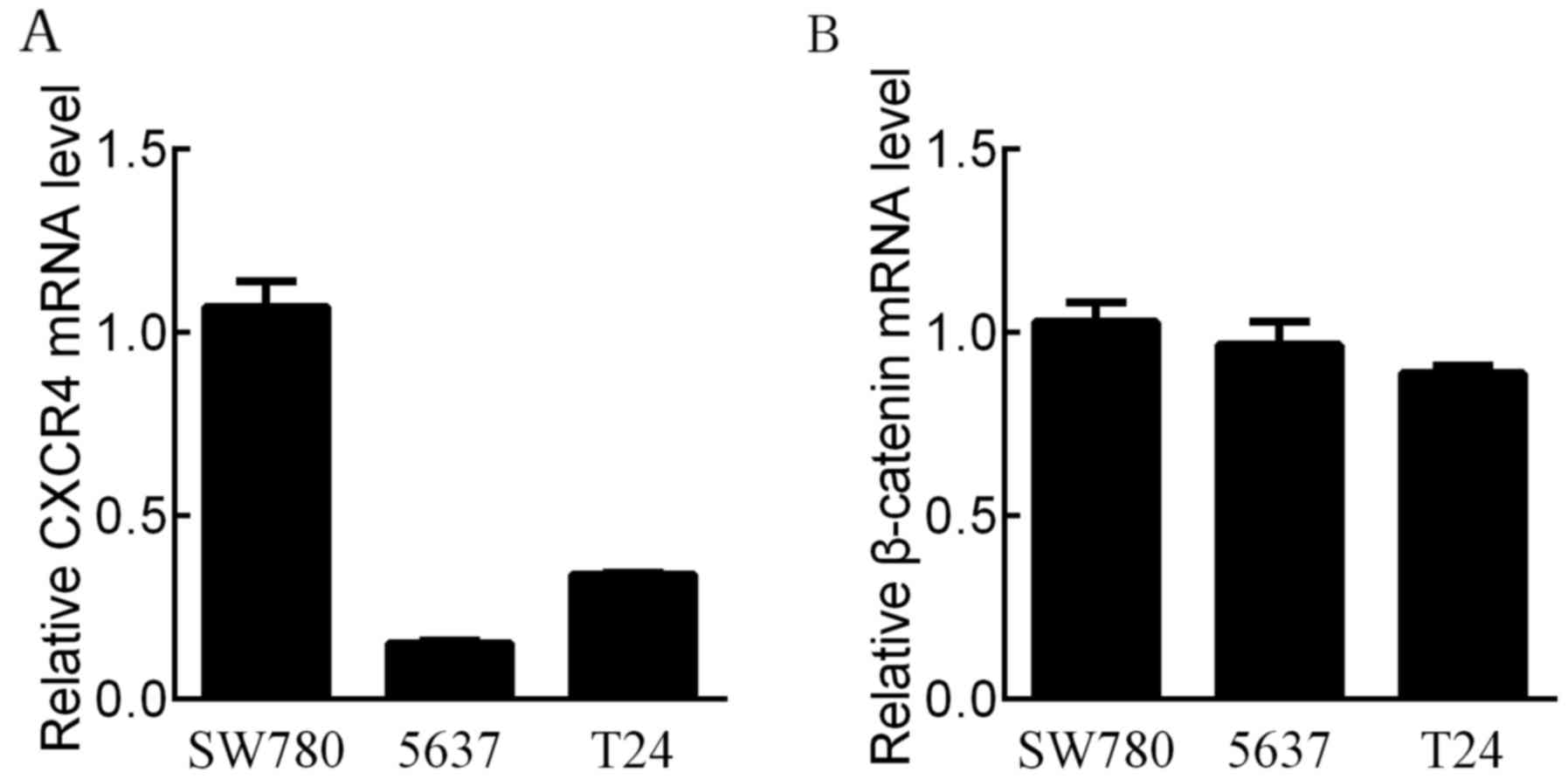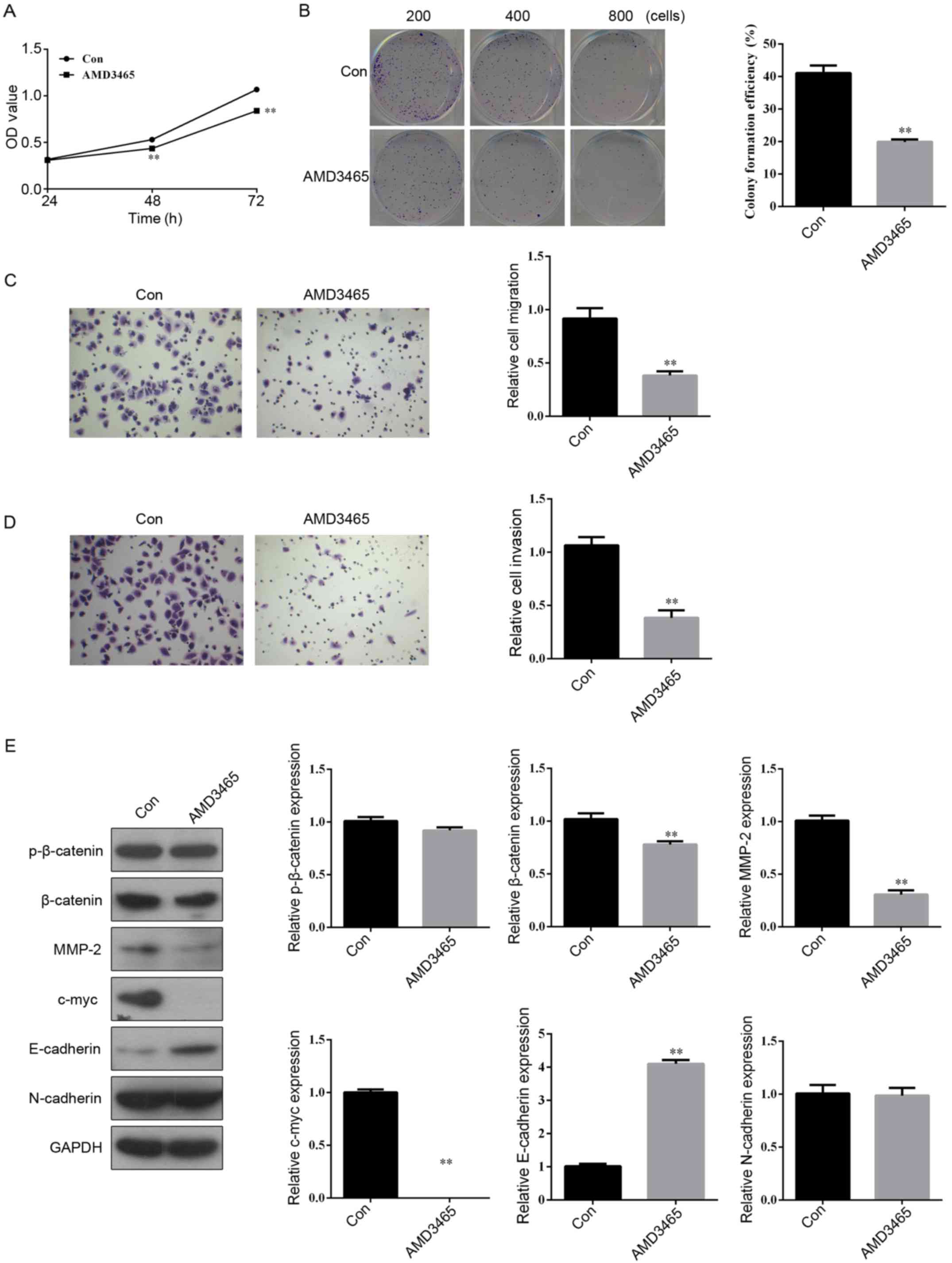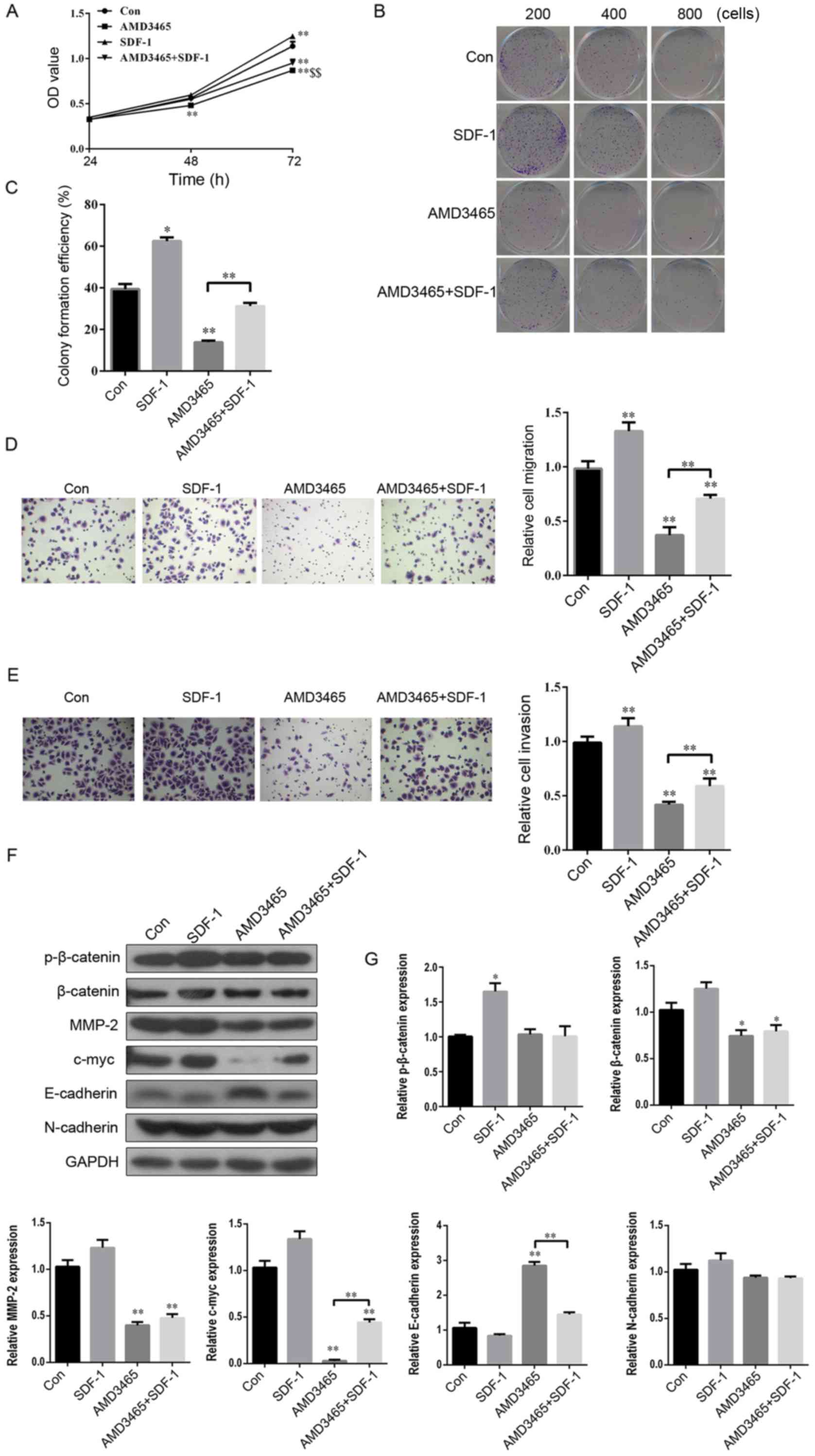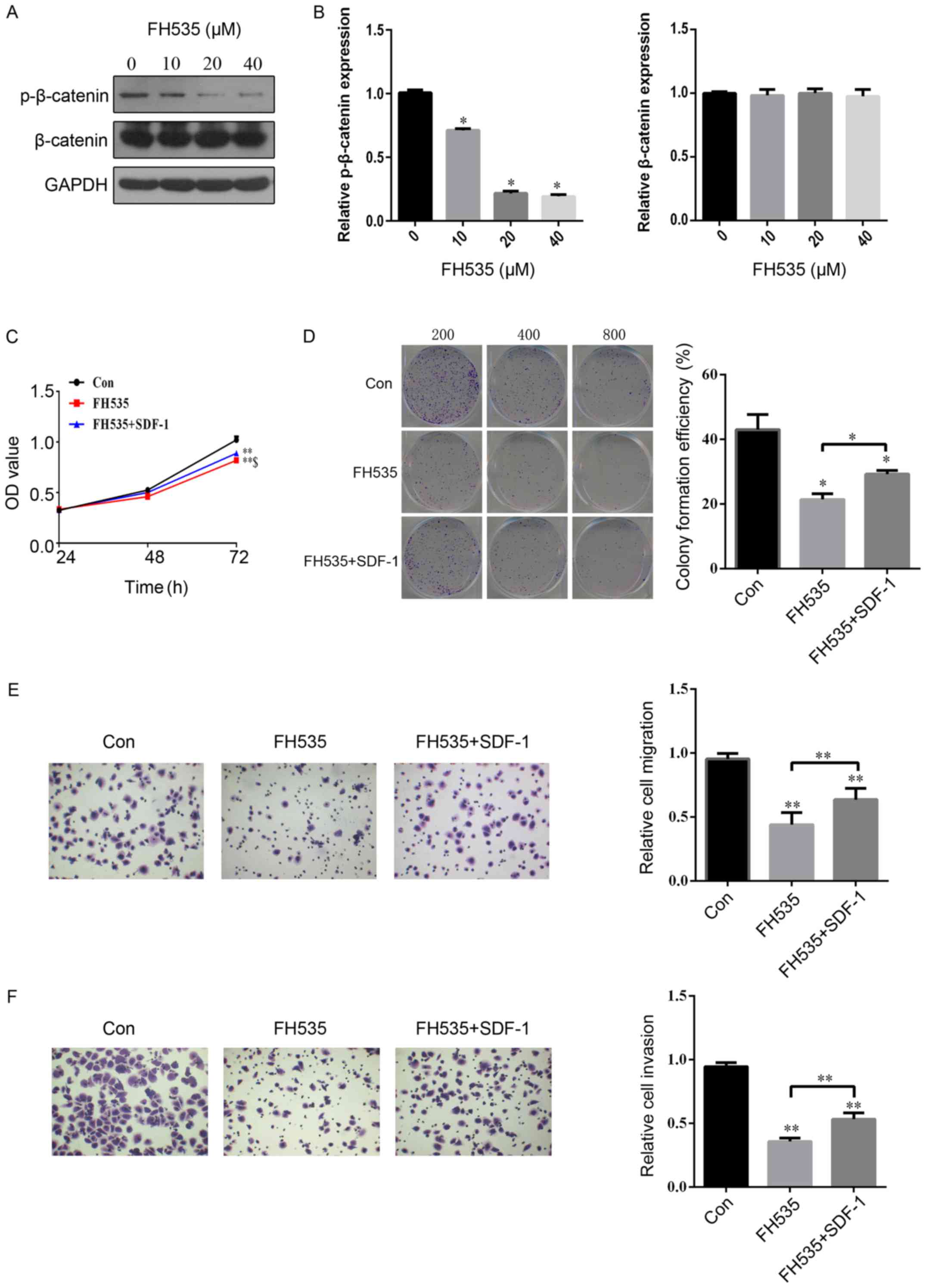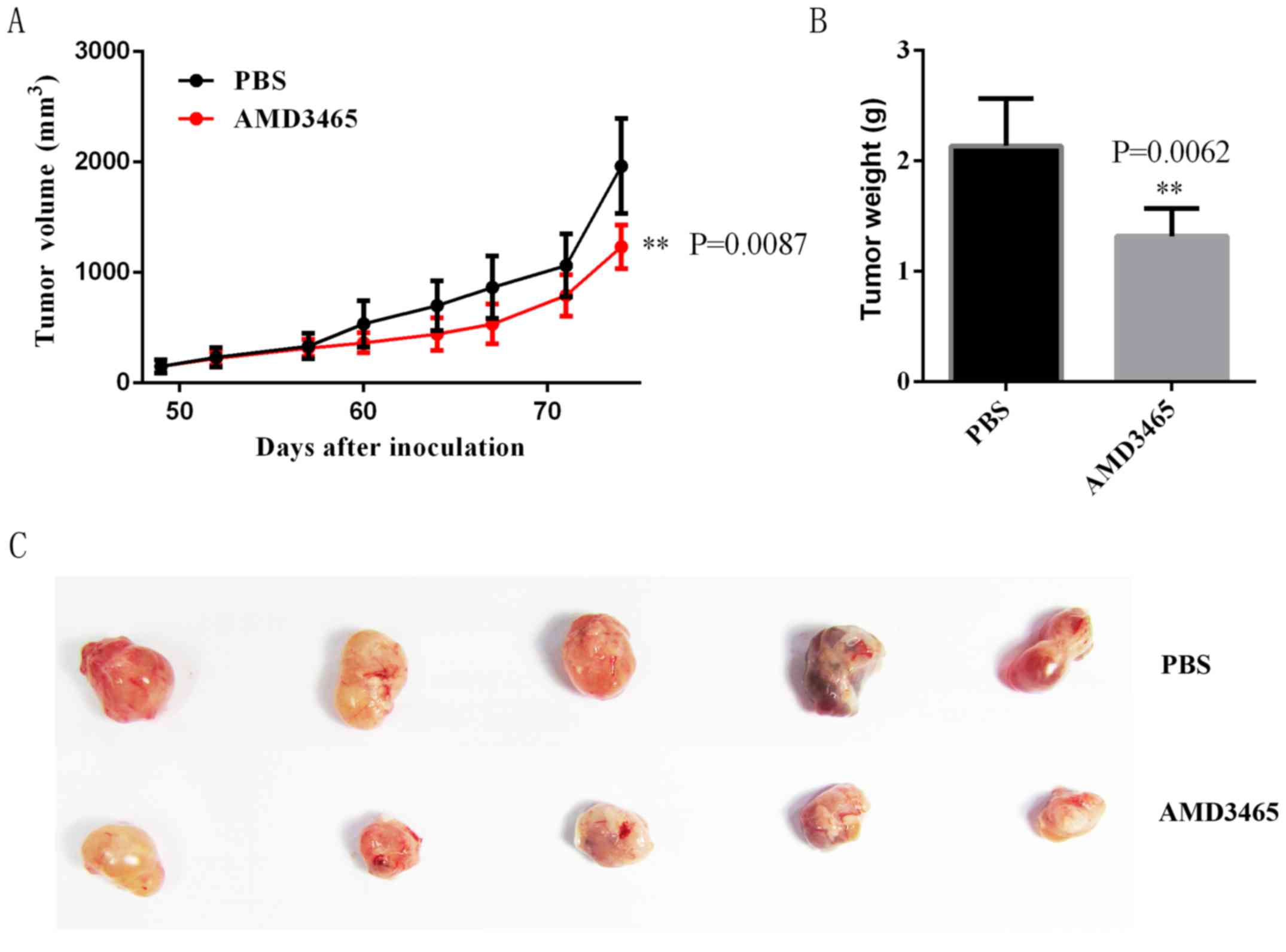|
1
|
Torre LA, Bray F, Siegel RL, Ferlay J,
Lortet-Tieulent J and Jemal A: Global cancer statistics, 2012. CA
Cancer J Clin. 65:87–108. 2015. View Article : Google Scholar : PubMed/NCBI
|
|
2
|
Chen W, Zheng R, Baade PD, Zhang S, Zeng
H, Bray F, Jemal A, Yu XQ and He J: Cancer statistics in China,
2015. CA Cancer J Clin. 66:115–132. 2016. View Article : Google Scholar : PubMed/NCBI
|
|
3
|
Raj GV, Karavadia S, Schlomer B, Arriaga
Y, Lotan Y, Sagalowsky A and Frenkel E: Contemporary use of
perioperative cisplatin-based chemotherapy in patients with
muscle-invasive bladder cancer. Cancer. 117:276–282. 2011.
View Article : Google Scholar : PubMed/NCBI
|
|
4
|
Sternberg CN, Skoneczna IA, Castellano D,
Theodore C, Blais N, Voog E, Bellmunt J, Peters F, Le-Guennec S,
Cerbone L, et al: Larotaxel with Cisplatin in the first-line
treatment of locally advanced/metastatic urothelial tract or
bladder cancer: A randomized, active-controlled, phase III trial
(CILAB). Oncology. 85:208–215. 2013. View Article : Google Scholar : PubMed/NCBI
|
|
5
|
Duda DG, Kozin SV, Kirkpatrick ND, Xu L,
Fukumura D and Jain RK: CXCL12 (SDF1alpha)-CXCR4/CXCR7 pathway
inhibition: An emerging sensitizer for anticancer therapies? Clin
Cancer Res. 17:2074–2080. 2011. View Article : Google Scholar : PubMed/NCBI
|
|
6
|
Teicher BA and Fricker SP: CXCL12
(SDF-1)/CXCR4 pathway in cancer. Clin Cancer Res. 16:2927–2931.
2010. View Article : Google Scholar : PubMed/NCBI
|
|
7
|
Meads MB, Hazlehurst LA and Dalton WS: The
bone marrow microenvironment as a tumor sanctuary and contributor
to drug resistance. Clin Cancer Res. 14:2519–2526. 2008. View Article : Google Scholar : PubMed/NCBI
|
|
8
|
Zheng N, Chen J, Liu W, Liu J, Li T, Chen
H, Wang J and Jia L: Mifepristone inhibits ovarian cancer
metastasis by intervening in SDF-1/CXCR4 chemokine axis.
Oncotarget. 8:59123–59135. 2017.PubMed/NCBI
|
|
9
|
De-Colle C, Menegakis A, Mönnich D, Welz
S, Boeke S, Sipos B, Fend F, Mauz PS, Tinhofer I, Budach V, et al:
SDF-1/CXCR4 expression is an independent negative prognostic
biomarker in patients with head and neck cancer after primary
radiochemotherapy. Radiother Oncol. 126:125–131. 2018. View Article : Google Scholar : PubMed/NCBI
|
|
10
|
Saigusa S, Toiyama Y, Tanaka K, Yokoe T,
Okugawa Y, Kawamoto A, Yasuda H, Inoue Y, Miki C and Kusunoki M:
Stromal CXCR4 and CXCL12 expression is associated with distant
recurrence and poor prognosis in rectal cancer after
chemoradiotherapy. Ann Surg Oncol. 17:2051–2058. 2010. View Article : Google Scholar : PubMed/NCBI
|
|
11
|
Hinton CV, Avraham S and Avraham HK: Role
of the CXCR4/CXCL12 signaling axis in breast cancer metastasis to
the brain. Clin Exp Metastasis. 27:97–105. 2010. View Article : Google Scholar : PubMed/NCBI
|
|
12
|
Li X, Li P, Chang Y, Xu Q, Wu Z, Ma Q and
Wang Z: The SDF-1/CXCR4 axis induces epithelial-mesenchymal
transition in hepatocellular carcinoma. Mol Cell Biochem.
392:77–84. 2014. View Article : Google Scholar : PubMed/NCBI
|
|
13
|
Wang B, Wang W, Niu W, Liu E, Liu X, Wang
J, Peng C, Liu S, Xu L, Wang L, et al: SDF-1/CXCR4 axis promotes
directional migration of colorectal cancer cells through
upregulation of integrin αvβ6. Carcinogenesis. 35:282–291. 2014.
View Article : Google Scholar : PubMed/NCBI
|
|
14
|
Guo Q, Gao BL, Zhang XJ, Liu GC, Xu F, Fan
QY, Zhang SJ, Yang B and Wu XH: CXCL12-CXCR4 axis promotes
proliferation, migration, invasion, and metastasis of ovarian
cancer. Oncol Res. 22:247–258. 2014. View Article : Google Scholar : PubMed/NCBI
|
|
15
|
Eisenhardt A, Frey U, Tack M, Rosskopf D,
Lümmen G, Rübben H and Siffert W: Expression analysis and potential
functional role of the CXCR4 chemokine receptor in bladder cancer.
Eur Urol. 47:111–117. 2005. View Article : Google Scholar : PubMed/NCBI
|
|
16
|
Gosalbez M, Hupe MC, Lokeshwar SD, Yates
TJ, Shields J, Veerapen MK, Merseburger AS, Rosser CJ, Soloway MS
and Lokeshwar VB: Differential expression of SDF-1 isoforms in
bladder cancer. J Urol. 191:1899–1905. 2014. View Article : Google Scholar : PubMed/NCBI
|
|
17
|
Retz MM, Sidhu SS, Blaveri E, Kerr SC,
Dolganov GM, Lehmann J, Carroll P, Simko J, Waldman FM and Basbaum
C: CXCR4 expression reflects tumor progression and regulates
motility of bladder cancer cells. Int J Cancer. 114:182–189. 2005.
View Article : Google Scholar : PubMed/NCBI
|
|
18
|
Lu Y, Hu B, Guan GF, Chen J, Wang CQ, Ma
Q, Wen YH, Qiu XC, Zhang XP and Zhou Y: SDF-1/CXCR4 promotes F5M2
osteosarcoma cell migration by activating the Wnt/β-catenin
signaling pathway. Med Oncol. 32:1942015. View Article : Google Scholar : PubMed/NCBI
|
|
19
|
Song ZY, Gao ZH, Chu JH, Han XZ and Qu XJ:
Downregulation of the CXCR4/CXCL12 axis blocks the activation of
the Wnt/β-catenin pathway in human colon cancer cells. Biomed
Pharmacother. 71:46–52. 2015. View Article : Google Scholar : PubMed/NCBI
|
|
20
|
Hu TH, Yao Y, Yu S, Han LL, Wang WJ, Guo
H, Tian T, Ruan ZP, Kang XM, Wang J, et al: SDF-1/CXCR4 promotes
epithelial-mesenchymal transition and progression of colorectal
cancer by activation of the Wnt/β-catenin signaling pathway. Cancer
Lett. 354:417–426. 2014. View Article : Google Scholar : PubMed/NCBI
|
|
21
|
Moon RT, Kohn AD, De Ferrari GV and Kaykas
A: WNT and beta-catenin signalling: Diseases and therapies. Nat Rev
Genet. 5:691–701. 2004. View
Article : Google Scholar : PubMed/NCBI
|
|
22
|
MacDonald BT, Tamai K and He X:
Wnt/beta-catenin signaling: Components, mechanisms, and diseases.
Dev Cell. 17:9–26. 2009. View Article : Google Scholar : PubMed/NCBI
|
|
23
|
Chen Z, Zhou L, Wang L, Kazobinka G, Zhang
X, Han X, Li B and Hou T: HBO1 promotes cell proliferation in
bladder cancer via activation of Wnt/β-catenin signaling. Mol
Carcinog. 57:12–21. 2018. View
Article : Google Scholar : PubMed/NCBI
|
|
24
|
Yuan H, Yu S, Cui Y, Men C, Yang D, Gao Z,
Zhu Z and Wu J: Knockdown of mediator subunit Med19 suppresses
bladder cancer cell proliferation and migration by downregulating
Wnt/β-catenin signalling pathway. J Cell Mol Med. 21:3254–3263.
2017. View Article : Google Scholar : PubMed/NCBI
|
|
25
|
Chan GK, Kleinheinz TL, Peterson D and
Moffat JG: A simple high-content cell cycle assay reveals frequent
discrepancies between cell number and ATP and MTS proliferation
assays. PLoS One. 8:e635832013. View Article : Google Scholar : PubMed/NCBI
|
|
26
|
Bodart V, Anastassov V, Darkes MC, Idzan
SR, Labrecque J, Lau G, Mosi RM, Neff KS, Nelson KL, Ruzek MC, et
al: Pharmacology of AMD3465: A small molecule antagonist of the
chemokine receptor CXCR4. Biochem Pharmacol. 78:993–1000. 2009.
View Article : Google Scholar : PubMed/NCBI
|
|
27
|
Chen Y, Rao X, Huang K, Jiang X, Wang H
and Teng L: FH535 inhibits proliferation and motility of colon
cancer cells by targeting Wnt/β-catenin signaling pathway. J
Cancer. 8:3142–3153. 2017. View Article : Google Scholar : PubMed/NCBI
|
|
28
|
Livak KJ and Schmittgen TD: Analysis of
relative gene expression data using real-time quantitative PCR and
the 2−ΔΔCT method. Methods. 25:402–408. 2001. View Article : Google Scholar : PubMed/NCBI
|
|
29
|
Xu YC, Liang CJ, Zhang DX, Li GQ, Gao X,
Fu JZ, Xia F, Ji JJ, Zhang LJ, Li GM, et al: : LncSHRG promotes
hepatocellular carcinoma progression by activating HES6.
Oncotarget. 8:70630–70641. 2017.PubMed/NCBI
|
|
30
|
Xie F, Xiang X, Huang Q, Ran P, Yuan Y, Li
Q, Qi G, Guo X, Xiao C and Zheng S: Reciprocal control of
lncRNA-BCAT1 and β-catenin pathway reveals lncRNA-BCAT1 long
non-coding RNA acts as a tumor suppressor in colorectal cancer.
Oncotarget. 8:23628–23637. 2017.PubMed/NCBI
|
|
31
|
Van Hout A, D'Huys T, Oeyen M, Schols D
and Van Loy T: Comparison of cell-based assays for the
identification and evaluation of competitive CXCR4 inhibitors. PLoS
One. 12:e01760572017. View Article : Google Scholar : PubMed/NCBI
|
|
32
|
Rossi D and Zlotnik A: The biology of
chemokines and their receptors. Annu Rev Immunol. 18:217–242. 2000.
View Article : Google Scholar : PubMed/NCBI
|
|
33
|
Muramaki M, Miyake H, Terakawa T, Kumano
M, Sakai I and Fujisawa M: Expression profile of E-cadherin and
N-cadherin in non-muscle-invasive bladder cancer as a novel
predictor of intravesical recurrence following transurethral
resection. Urol Oncol. 30:161–166. 2012. View Article : Google Scholar : PubMed/NCBI
|
|
34
|
Olbert PJ, Kesch C, Henrici M, Subtil FS,
Honacker A, Hegele A, Hofmann R and Hänze J: TLR4- and
TLR9-dependent effects on cytokines, cell viability, and invasion
in human bladder cancer cells. Urol Oncol. 33:110.e19–e27. 2015.
View Article : Google Scholar
|
|
35
|
Yates TJ, Knapp J, Gosalbez M, Lokeshwar
SD, Gomez CS, Benitez A, Ekwenna OO, Young EE, Manoharan M and
Lokeshwar VB: C-X-C chemokine receptor 7: A functionally associated
molecular marker for bladder cancer. Cancer. 119:61–71. 2013.
View Article : Google Scholar : PubMed/NCBI
|
|
36
|
Wang H, Yang D, Wang K and Wang J:
Expression and potential role of chemokine receptor CXCR4 in human
bladder carcinoma cell lines with different metastatic ability. Mol
Med Rep. 4:525–528. 2011.PubMed/NCBI
|
|
37
|
Shen CH, Wu JD, Jou YC, Cheng MC, Lin CT,
Chen PC, Tseng YS, Shi CS, Chen SY, Chang DC, et al: The
correlation between TWIST, E-cadherin, and beta-catenin in human
bladder cancer. J BUON. 16:733–737. 2011.PubMed/NCBI
|
|
38
|
Nakopoulou L, Zervas A,
Gakiopoulou-Givalou H, Constantinides C, Doumanis G, Davaris P and
Dimopoulos C: Prognostic value of E-cadherin, beta-catenin, P120ctn
in patients with transitional cell bladder cancer. Anticancer Res.
20:4571–4578. 2000.PubMed/NCBI
|
|
39
|
Du HF, Ou LP, Lv CK, Yang X, Song XD, Fan
YR, Wu XH and Luo CL: Expression of hepaCAM inhibits bladder cancer
cell proliferation via a Wnt/β-catenin-dependent pathway in vitro
and in vivo. Cancer Biol Ther. 16:1502–1513. 2015. View Article : Google Scholar : PubMed/NCBI
|
|
40
|
Luo M, Li Z, Wang W, Zeng Y, Liu Z and Qiu
J: Long non-coding RNA H19 increases bladder cancer metastasis by
associating with EZH2 and inhibiting E-cadherin expression. Cancer
Lett. 333:213–221. 2013. View Article : Google Scholar : PubMed/NCBI
|
|
41
|
Vaid M, Prasad R, Sun Q and Katiyar SK:
Silymarin targets β-catenin signaling in blocking
migration/invasion of human melanoma cells. PLoS One. 6:e230002011.
View Article : Google Scholar : PubMed/NCBI
|
|
42
|
Ye W, Chen C, Gao Y, Zheng ZS, Xu Y, Yun
M, Weng HW, Xie D, Ye S and Zhang JX: Overexpression of SLC34A2 is
an independent prognostic indicator in bladder cancer and its
depletion suppresses tumor growth via decreasing c-Myc expression
and transcriptional activity. Cell Death Dis. 8:e25812017.
View Article : Google Scholar : PubMed/NCBI
|
|
43
|
Tang Y, Simoneau AR, Liao WX, Yi G, Hope
C, Liu F, Li S, Xie J, Holcombe RF, Jurnak FA, et al: WIF1, a Wnt
pathway inhibitor, regulates SKP2 and c-myc expression leading to
G1 arrest and growth inhibition of human invasive urinary bladder
cancer cells. Mol Cancer Ther. 8:458–468. 2009. View Article : Google Scholar : PubMed/NCBI
|
|
44
|
Gao Y, Guan Z, Chen J, Xie H, Yang Z, Fan
J, Wang X and Li L: CXCL5/CXCR2 axis promotes bladder cancer cell
migration and invasion by activating PI3K/AKT-induced upregulation
of MMP2/MMP9. Int J Oncol. 47:690–700. 2015. View Article : Google Scholar : PubMed/NCBI
|
|
45
|
Wu K, Ning Z, Zeng J, Fan J, Zhou J, Zhang
T, Zhang L, Chen Y, Gao Y, Wang B, et al: Silibinin inhibits
β-catenin/ZEB1 signaling and suppresses bladder cancer metastasis
via dual-blocking epithelial-mesenchymal transition and stemness.
Cell Signal. 25:2625–2633. 2013. View Article : Google Scholar : PubMed/NCBI
|
|
46
|
Wang Z, Ma Q, Liu Q, Yu H, Zhao L, Shen S
and Yao J: Blockade of SDF-1/CXCR4 signalling inhibits pancreatic
cancer progression in vitro via inactivation of canonical Wnt
pathway. Br J Cancer. 99:1695–1703. 2008. View Article : Google Scholar : PubMed/NCBI
|
|
47
|
Liu Z, Hao C, Song D, Zhang N, Bao H and
Qu Q: Androgen receptor coregulator CTBP1-AS is associated with
polycystic ovary syndrome in Chinese Women: A preliminary study.
Reprod Sci. 22:829–837. 2015. View Article : Google Scholar : PubMed/NCBI
|
|
48
|
Castellone MD, De Falco V, Rao DM,
Bellelli R, Muthu M, Basolo F, Fusco A, Gutkind JS and Santoro M:
The beta-catenin axis integrates multiple signals downstream from
RET/papillary thyroid carcinoma leading to cell proliferation.
Cancer Res. 69:1867–1876. 2009. View Article : Google Scholar : PubMed/NCBI
|















